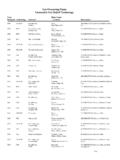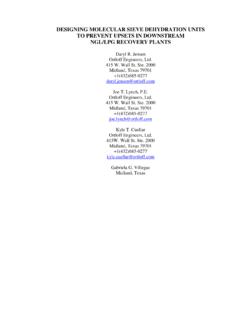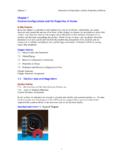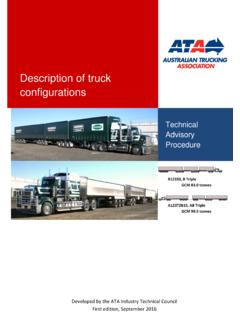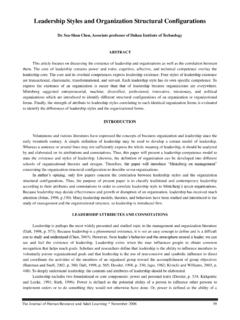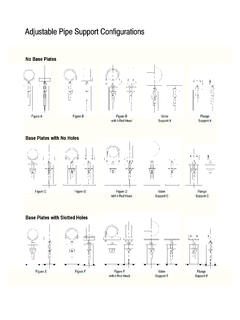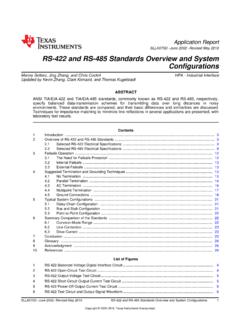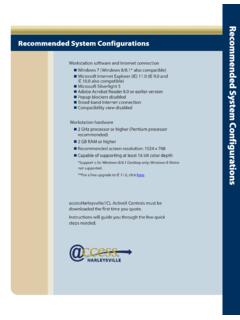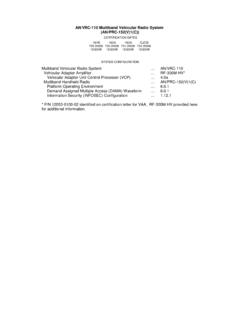Transcription of Sulfur Plant Configurations for Weird Acid Gases - Ortloff
1 Sulfur Plant Configurations for Weird acid Gases Presented at the 2013 Laurance Reid Gas Conditioning Conference The University of Oklahoma February 24-27th, 2013 Mrs. Kelley LaRue Mrs. Susan Grigson, Mr. Hank Hudson, Ortloff Engineers, Ltd. 415 W Wall St., Suite 2000 Midland, Texas 79701 USA +1 (432) 685-0277 Sulfur Plant Configurations FOR Weird acid Gases LRGCC - Laurance Reid Gas Conditioning Conference - February 24-27, 2013 Page 1 1. ABSTRACT The rise in unconventional natural gas production, along with the growing interest in clean coal technologies and other alternative energy sources, has created a number of interesting challenges for Sulfur Plant designers. More and more, Sulfur plants must be designed to recover Sulfur from very lean acid Gases or acid Gases that contain contaminates such as methanol, heavy hydrocarbons, BTEX (benzene, toluene, ethyl-benzene, and xylene), ammonia, and/or cyanide.
2 In addition, national and international emissions standards continue to become more stringent, requiring facilities to achieve increasingly higher recovery levels. A number of new projects have required non-standard Sulfur Plant Configurations to address the dual challenges of low-quality acid gas and strict emissions requirements, while still preserving the high reliability and ease of operation that Sulfur Plant operators desire. This paper reviews the capabilities of various Sulfur recovery technologies and the ranges of applicability for each, and discusses the impact of various acid gas contaminates on the design of a Sulfur recovery facility. In addition, this paper presents information that a Sulfur Plant designer can use to arrive at an optimum facility configuration for a variety of acid gas compositions and Sulfur recovery levels.
3 2. INTRODUCTION The global energy portfolio has changed considerably in the last decade. Advances in technology have led to an increase in unconventional natural gas production, as well as an increase in the number of proposed and operating coal gasification facilities world-wide. At the same time, environmental regulations, particularly maximum allowable SO2 emissions, have become more stringent around the world. The following are the SO2 emissions standards required by the World Bank, which provides the financing for many new processing facilities: Natural Gas Processing: 75 mg/Nm3 (~25 ppmv) dry, 15% O21 Petroleum Refining: 150 mg/Nm3 (~50 ppmv) dry, 3% O22 Coal Processing (Gasification): 150 mg/Nm3 (~50 ppmv) dry, 15% O23 For comparison, the United States typically requires less than 250 ppmv of SO2 on a dry, no excess oxygen basis for refinery Sulfur recovery plants .
4 These changes in both feed streams and emissions limits have created a number of challenges for Sulfur Plant designers. Sour unconventional natural gas often has a higher CO2:H2S ratio than conventional gas sources, which results in leaner (lower H2S concentration) acid gas feed streams. Likewise, the acid Gases produced from treating syngas from coal gasifiers are often much leaner than traditional refinery or gas Plant acid Gases . In addition, acid Gases from both of these sources frequently contain contaminants such as methanol, heavy hydrocarbons, BTEX, ammonia, and/or cyanide, all of which can cause operating problems in Sulfur recovery units (SRUs). The purpose of this paper is to (1) review the various technologies available for recovering Sulfur from lean acid gas streams, (2) examine the effects that different contaminants have on these processes and propose strategies to mitigate these effects, (3) attempt to quantify the recovery efficiencies and corresponding SO2 emissions that can be achieved with various technologies when processing lean or contaminated acid Gases , and (4) provide guidance for selecting the optimum facility configuration for various applications.
5 Sulfur Plant Configurations FOR Weird acid Gases LRGCC - Laurance Reid Gas Conditioning Conference - February 24-27, 2013 Page 2 3. RECOVERY VS. SO2 EMISSIONS The single most important piece of information any Sulfur Plant designer needs to know to begin designing a Sulfur recovery facility is the required Sulfur recovery efficiency. This requirement will often dictate the process configuration or technology selection because not all of the well-established Sulfur recovery processes are capable of achieving the same recovery efficiency. Unfortunately, Sulfur Plant designers are often given inconsistent or even contradictory recovery specifications. Since the cost of a facility almost always increases with increasing recovery efficiency, this can lead a designer to propose a process design that may be more costly to build than what is really required, or that may not meet all of the specifications for the project.
6 In very simple terms, the Sulfur recovery efficiency is the percentage of the total Sulfur (H2S and other Sulfur -containing compounds) in the acid gas feed stream(s) that is recovered as elemental Sulfur in a Sulfur Plant . However, while technically true, that definition is often not very useful. In practice, the Sulfur recovery efficiency required for a given facility is almost always dictated by environmental regulations, which vary from state to state, from province to province, and from country to country. In many cases, a more accurate statement is that the required Sulfur recovery efficiency is a function of the maximum allowable SO2 emissions for a given location. Since any Sulfur that is not recovered in the Sulfur Plant is incinerated in the tailgas thermal oxidizer (TTO) to SO2, the maximum allowable SO2 emissions in the TTO vent gas effectively dictates the quantity of Sulfur that must be recovered in the Sulfur Plant .
7 It is worth noting that while Sulfur recovery efficiency and SO2 emissions are directly related, recovery efficiency is typically specified as a percentage, whereas allowable SO2 emissions are almost always specified as a concentration. In other words, SO2 emissions (as they are commonly reported) are a function of both the Sulfur recovery efficiency and the quantity of other diluents (nitrogen, carbon dioxide, etc.) in the vent gas. This is an important distinction because, while it may seem counter-intuitive, in some cases the technology or Plant configuration that achieves the highest Sulfur recovery efficiency may not be the technology or configuration that achieves the lowest SO2 emissions.
8 This is especially true for leaner acid gas streams. 4. Sulfur RECOVERY TECHNOLOGIES When designing a new Sulfur recovery facility, there are a number of well-established technologies to choose from. So, the first step is to understand the ranges of applicability for each type of process, and the Sulfur recovery efficiency each type of process can achieve. The following is a list of the Sulfur recovery technologies that were considered as part of this study: Primary Sulfur Removal Tailgas Cleanup H2S Scavengers Sub-Dewpoint Claus (CBA, MCRC , Sulfreen ) Liquid Redox (LO-CAT , SulFerox , CrystaSulf ) Direct-Oxidation Claus (SUPERCLAUS , EUROCLAUS ) Biological Processes (THIOPAQ O&G) Reduction/Absorption/Recycle Tailgas Cleanup (SCOT and SCOT -Type) Selectox & Recycle Selectox SO2 Recycle (CANSOLV TGT+, ClausMaster ) Modified Claus SOX Scrubbing (DynaWave ) Sulfur Plant Configurations FOR Weird acid Gases LRGCC - Laurance Reid Gas Conditioning Conference - February 24-27, 2013 Page 3 Descriptions of each of these technologies are provided in Appendix A.
9 In general, each of these processes or technologies falls into one of two categories: those used for primary (or bulk) Sulfur removal from either sour gas or acid gas streams, and those used in addition to a primary Sulfur removal process to increase the overall Sulfur recovery to 98% +. This second type of process is generally referred to as a Tailgas Cleanup (TGCU) process. 5. TECHNOLOGY SELECTION FOR LEAN acid Gases One of the primary goals of this paper is to aid Sulfur Plant designers in selecting the one or two optimum SRU Configurations for a given application from the many, many choices available today. Accordingly, a variety of Sulfur Plant processes and Configurations were modeled using Ortloff ' s Sulfur Recovery Systems Simulator program, Sulfur .
10 Sulfur can model completely integrated Claus, CBA, Selectox, and oxygen-enriched Sulfur plants combined with SCOT -type tailgas cleanup units and/or incineration systems. The accuracy of the program has been verified in many actual Sulfur recovery plants . The following SRU Configurations were modeled: a. 3-Stage Claus + TTO b. 2+2-Stage Claus/CBA (2-Stage Claus + 2-bed CBA Sub-Dewpoint) + TTO c. Recycle Selectox + 2-Stage Claus + TTO d. Recycle Selectox + 1+2 Claus/CBA (1-Stage Claus + 2-bed CBA Sub-Dewpoint) + TTO e. 3-Stage Claus + SCOT -type TGCU + TTO The compositions of the acid gas feed streams, as well as all other assumptions, utility conditions, etc., are documented in Appendix B. H2S scavengers were excluded from this analysis because they are generally recommended for gas streams containing less than 200-400 lb/day (90-180 kg/day) of Sulfur .
